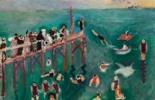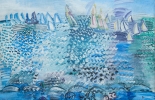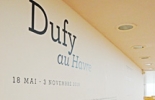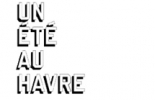Raoul Dufy in Le Havre
from May 18 to November 03, 2019
Raoul Dufy was born in Le Havre in 1877. It was where he trained and took his first steps as an artist. He retained a deep, lifelong attachment to the city, and its maritime setting provided subjects for many of his works. More than any other subject, Le Havre embodies his successive explorations of the field of light and colour, from his early Impressionist works to his final Black Cargo Ships series via his early attraction to Realism, Fauvism, the influence of Cézanne and what could be called his blue period between the two world wars.
Dufy remained moored to Le Havre throughout his life. It was his ideal city - a landscape of the mind that supplied his favourite subjects.
Dufy remained moored to Le Havre throughout his life. It was his ideal city - a landscape of the mind that supplied his favourite subjects.
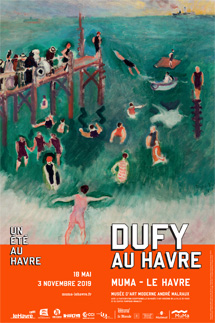
In this exhibition, MuMa Le Havre presents a set of artworks that have never previously been displayed together to reconsider the oeuvre of a great twentiethcentury artist from a fresh perspective. Juxtaposing paintings and works on paper from differing periods reveals a fascinating shift in Dufy’s relationship with the subject. At first faithfully rendered, the bay of Le Havre and Sainte-Adresse is gradually recomposed and synthesized, then finally reinvented. At the end of his life, far from Le Havre, Dufy was constantly to return to it as a subject: for him, it had now truly become an inner landscape.
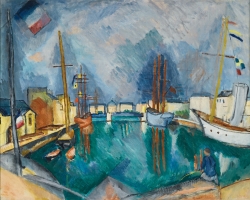
Raoul DUFY (1877-1953), The Port of Le Havre, vers 1910, oil on canvas, 65.5 x 81.4 cm. Private collection. © Sotheby's, New York / Adagp, Paris 2019
Raoul Dufy (1877-1953) ranks among the major artists of the first half of the twentieth century. He was born in Le Havre and, like Eugène Boudin and Claude Monet, retained a lifelong attachment to the city and harbour that formed the backdrop for their childhoods and artistic beginnings. Le Havre was the scene of Dufy’s first forays into art. The harbour and the seaside resort took pride of place in his oeuvre, furnishing a host of subjects which he constantly revisited throughout his career, dwelling alternately on particular motifs. But Le Havre is as much an atmosphere as a city. Few of its buildings feature in Dufy’s works. He was chiefly interested in the ambience of port life and the seaside holiday resort:the harbour and the quays, the casino, the beach and the never-ending spectacle of the boats and bathers. Le Havre also has a particular light. Unhappy the man who lives far from the sea. The painter needs constantly to have before his eyes a certain type of light, a glittering quality, an aerial caress that bathes what he sees, as Dufy put it.
Dufy still had family in Le Havre, and regularly stayed there. Even when he was far away, he constantly painted his home city from memory. It was the beach of Le Havre and Sainte-Adresse, flanked by Le Havre’s harbour entrance and jetties at one end and the cliffs of the Pays de Caux at the other, that provided the setting for his last experiments with
light and colour in his final Black Cargo Ships series of paintings.
MuMa’s substantial Dufy collection
MuMa has in its keeping an outstanding collection of 128 works by Dufy consisting of 37 paintings, 63 drawings, one tapestry, three ceramic items, eight works on textiles and several editions of his engravings. Together, they provide a record of the output of a highly prolific artist capable of working in many media.
Most of these works were part of the set bequeathed to the museum by Madame Dufy on her death in 1962, comprising 30 oil paintings, 30 drawings, five watercolours, three ceramic artworks and one tapestry by Raoul Dufy, plus a bronze of the artist. The bequest was supplemented by 21 other works from the Dufy estate, which were deposited with MuMa by the Musée national d’art moderne in 1974, and an additional drawing deposited in 2015.
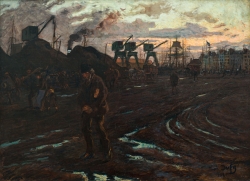
Raoul DUFY (1877-1953), End of the Day at Le Havre, 1901, oil on canvas, 99 x 135 cm. . © MuMa Le Havre / David Fogel — © ADAGP, Paris, 2014
The collection chronicles Dufy’s entire output. It includes youthful works from the beginning of his career, such as the four watercolours donated to the City of Le Havre in 1900. His Fauvist period is represented notably by Le Yacht Pavoisé (The Yacht Decked with Flags) and his Cézannean period by Le Casino Marie-Christine (The Marie-Christine Casino). Hommage à Claude Debussy (Tribute to Claude Debussy), produced a few months before Dufy died in Forcalquier, records the final phase of his oeuvre.
Exhibition Curators :
Sophie Krebs, General Heritage Curator Musée d’Art Moderne de la Ville de Paris
Annette Haudiquet, Chief Heritage Curator Director of MuMa – André Malraux Museum of Modern Art in Le Havre
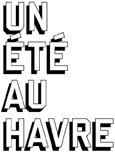
"A Summer in Le Havre" is devised by artistic director Jean Blaise and coordinated by the GIP (public interest group) "Le Havre 2017" made up of the City of Le Havre, the Urban Community Le Havre Seine Métropole, the Grand Port Maritime du Havre (Le Havre Port Authority), the Seine Estuary Chamber of Commerce and Industry, the Department of Seine-Maritime, the Normandy Region and the University of Le Havre.
MORE +


